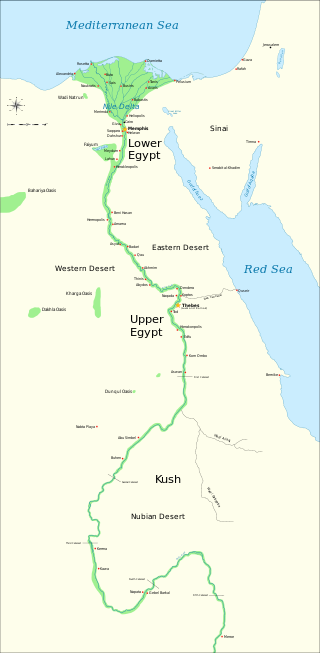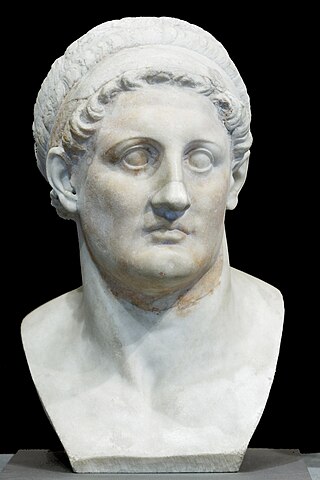Related Research Articles

Ancient Egypt was a civilization of ancient Northeast Africa, concentrated along the lower reaches of the Nile River, situated in the place that is now the country Egypt. Ancient Egyptian civilization followed prehistoric Egypt and coalesced around 3100 BC with the political unification of Upper and Lower Egypt under Menes. The history of ancient Egypt occurred as a series of stable kingdoms, separated by periods of relative instability known as Intermediate Periods: the Old Kingdom of the Early Bronze Age, the Middle Kingdom of the Middle Bronze Age and the New Kingdom of the Late Bronze Age.

The Six-Day War or June War, also known as the 1967 Arab–Israeli War or Third Arab–Israeli War, was fought between Israel and a coalition of Arab states from 5 to 10 June 1967.

The 1948 Arab–Israeli War, also known as the First Arab–Israeli War, followed the civil war in Mandatory Palestine as the second and final stage of the 1948 Palestine war. It formally began following the end of the British Mandate for Palestine at midnight on 14 May 1948; the Israeli Declaration of Independence had been issued earlier that day, and a military coalition of Arab states entered the territory of Mandatory Palestine in the morning of 15 May.

Cleopatra VII Thea Philopator was Queen of the Ptolemaic Kingdom of Egypt from 51 to 30 BC, and its last active ruler. A member of the Ptolemaic dynasty, she was a descendant of its founder Ptolemy I Soter, a Macedonian Greek general and companion of Alexander the Great. After the death of Cleopatra, Egypt became a province of the Roman Empire, marking the end of the last Hellenistic-period state in the Mediterranean and of the age that had lasted since the reign of Alexander. Her first language was Koine Greek, and she was the only known Ptolemaic ruler to learn the Egyptian language.

Thoth is an ancient Egyptian deity. In art, he was often depicted as a man with the head of an ibis or a baboon, animals sacred to him. His feminine counterpart was Seshat, and his wife was Ma'at. He was the god of the Moon, wisdom, knowledge, writing, hieroglyphs, science, magic, art and judgment.

Ptolemy I Soter was a Macedonian Greek general, historian and successor of Alexander the Great who went on to found the Ptolemaic Kingdom centered on Egypt and led by the Ptolemaic dynasty from 305 BC – 30 BC. Ptolemy was basileus and pharaoh of Ptolemaic Egypt from 305/304 BC to his death, during which time Egypt became a thriving bastion of Hellenistic civilization and Alexandria a great seat of Greek culture.

Usermaatre Meryamun Ramesses III was the second Pharaoh of the Twentieth Dynasty in Ancient Egypt. He is thought to have reigned from 26 March 1186 to 15 April 1155 BC and is considered to be the last great monarch of the New Kingdom to wield any substantial authority over Egypt.

Thutmose III, sometimes called Thutmose the Great, was the sixth pharaoh of the 18th Dynasty. Officially he ruled Egypt from 28 April 1479 BC until 11 March 1425 BC, commencing with his coronation at the age of two and concluding with his death, aged fifty-six; however, during the first 22 years of his reign, he was coregent with his stepmother and aunt, Hatshepsut, who was named the pharaoh. While he was shown first on surviving monuments, both were assigned the usual royal names and insignia and neither is given any obvious seniority over the other. Thutmose served as the head of Hatshepsut's armies. During the final two years of his reign, he appointed his son and successor, Amenhotep II, as his junior co-regent. His firstborn son and heir to the throne, Amenemhat, predeceased Thutmose III.

The Battle of Kadesh took place between the Egyptian Empire and the Hittite Empire in the 13th century BC, with the former led by Ramesses II and the latter led by Muwatalli II. Both sides engaged each other at the Orontes River, just upstream of Lake Homs and near the archaeological site of Kadesh, along what is today the Lebanon–Syria border.

The New Kingdom, also referred to as the Egyptian Empire, was the ancient Egyptian nation between the 16th century BC and the 11th century BC. This period of ancient Egyptian history covers the Eighteenth, Nineteenth, and Twentieth Dynasties. Through radiocarbon dating, the establishment of the New Kingdom has been placed between 1570 BC and 1544 BC. The New Kingdom followed the Second Intermediate Period and was succeeded by the Third Intermediate Period. It was the most prosperous time for the Egyptian people and marked the peak of Egypt's power.

The Late Period of ancient Egypt refers to the last flowering of native Egyptian rulers after the Third Intermediate Period in the 26th Saite Dynasty founded by Psamtik I, but includes the time of Achaemenid Persian rule over Egypt after the conquest by Cambyses II in 525 BC as well. The Late Period existed from 664 BC until 332 BC, following a period of foreign rule by the Nubian 25th Dynasty and beginning with a short period of Neo-Assyrian suzerainty, with Psamtik I initially ruling as their vassal. The period ended with the conquests of the Persian Empire by Alexander the Great and establishment of the Ptolemaic dynasty by his general Ptolemy I Soter, one of the Hellenistic diadochi from Macedon in northern Greece. With the Macedonian Greek conquest in the latter half of the 4th century BC, the age of Hellenistic Egypt began.

The Ptolemaic Kingdom or Ptolemaic Empire was an Ancient Greek state based in Egypt during the Hellenistic period. It was founded in 305 BC by the Macedonian general Ptolemy I Soter, a companion of Alexander the Great, and ruled by the Ptolemaic dynasty until the death of Cleopatra VII in 30 BC. Reigning for nearly three centuries, the Ptolemies were the longest and final dynasty of ancient Egypt heralding a distinctly new era for religious syncretism and the blending of a new Greco-Egyptian culture.
The Kehek were a minor Ancient Libyan group that battled with the Egyptians during the New Kingdom of Egypt. It is also believed that this might be an ancient city whose location is unknown. They are mentioned in Papyrus Anastasi I as part of Egyptian troops in theoretical invasion to Djahy along with Sherden, Meswesh, Nubians and Egyptian archers. They were also employed as an auxiliary foreign corps in Egypt after their defeat to Ramses III, in Memphis in 1188 B.C.

The Battle of the Delta was a sea battle between Egypt and the Sea Peoples, circa 1175 BC, when the Egyptian pharaoh Ramesses III repulsed a major sea invasion. The conflict occurred on the shores of the eastern Nile Delta and on the border of the Egyptian Empire in Syria, although precise locations of the battles are unknown. This major conflict is recorded on the temple walls of the mortuary temple of pharaoh Ramesses III at Medinet Habu.

The Battle of Djahy was a major land battle between the forces of Pharaoh Ramesses III and the Sea Peoples who intended to invade and conquer Egypt. The conflict occurred on the Egyptian Empire's easternmost frontier in Djahy, or modern-day southern Lebanon, in the eighth year of Ramesses III or about c. 1178 BC.

Ramesses II, commonly known as Ramesses the Great, was an Egyptian pharaoh. He was the third ruler of the Nineteenth Dynasty. Along with Thutmose III of the Eighteenth Dynasty, he is often regarded as the greatest, most celebrated, and most powerful pharaoh of the New Kingdom, which itself was the most powerful period of ancient Egypt. He is also widely considered one of ancient Egypt's most successful warrior pharaohs, conducting no fewer than 15 military campaigns, all resulting in victories, excluding the Battle of Kadesh, generally considered a stalemate.

The following outline is provided as an overview of a topical guide to ancient Egypt:

The Twentieth Dynasty of Egypt is the third and last dynasty of the Ancient Egyptian New Kingdom period, lasting from 1189 BC to 1077 BC. The 19th and 20th Dynasties furthermore together constitute an era known as the Ramesside period. This dynasty is generally considered to be the start of the decline of Ancient Egypt.
The Battle of Perire was fought around 1208 BC between the New Kingdom of Egypt, led by the pharaoh Merneptah, and a coalition of Libyan tribes and Sea Peoples. The Egyptians won a decisive victory. This was the first of many encounters between Egypt and the Sea Peoples. Our main source of information about this battle comes from the Great Karnak Inscription.
References
- ↑ "Thesaurus Linguae Aegyptiae - Login". aaew.bbaw.de. Retrieved 2019-07-12.
- ↑ Gardiner, Alan. Egypt of the Pharaohs. Oxford University Press, 1961., p.285.
- ↑ Steindorff, George. When Egypt Ruled the East. p. 47. University of Chicago Press, 1942.